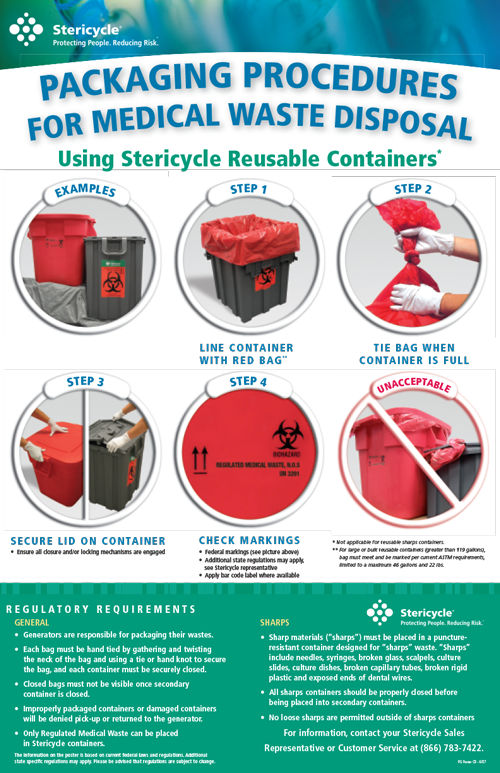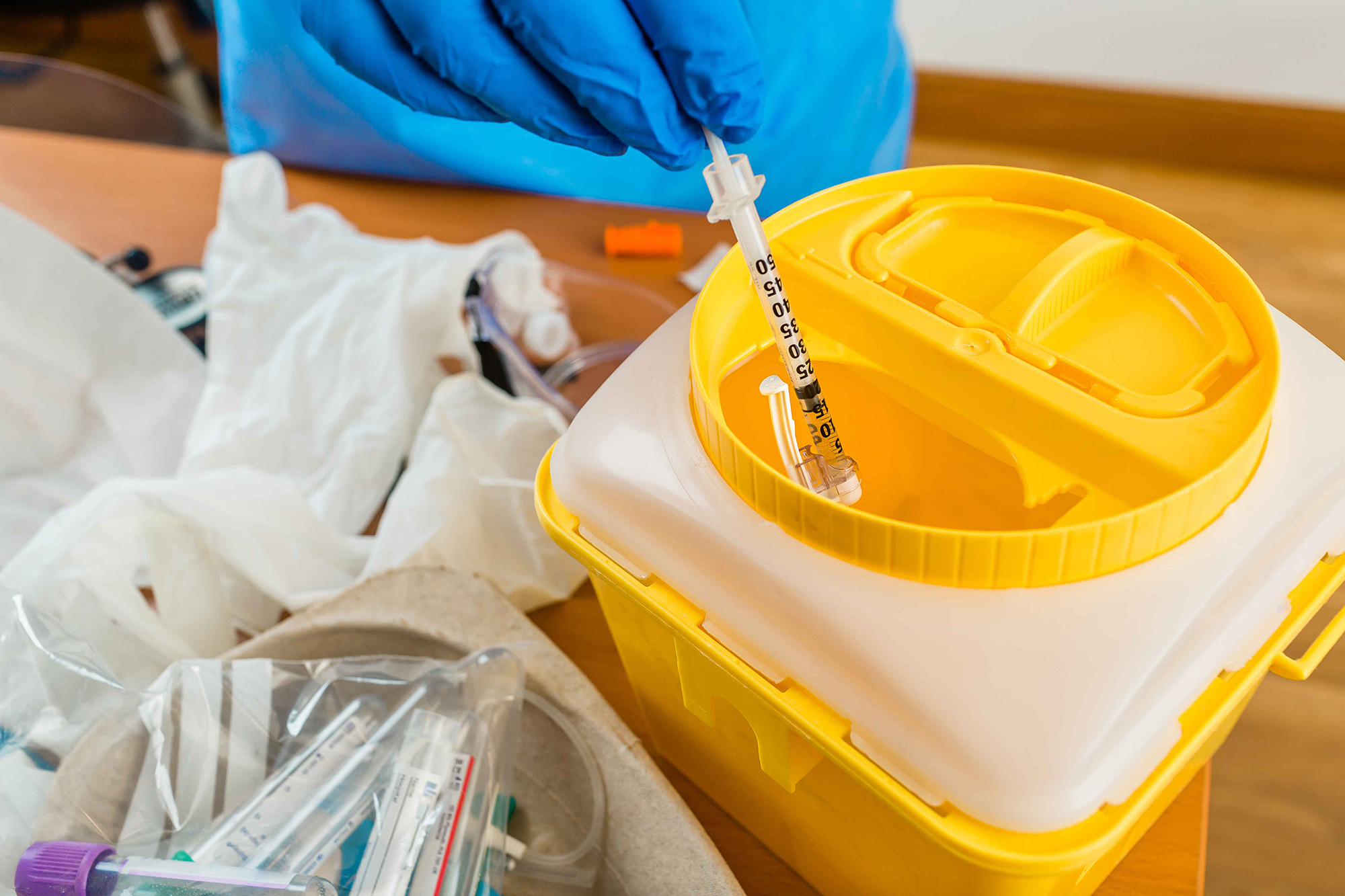Best Practices for Medical Waste Management
Medical waste administration is a crucial aspect of healthcare centers' operations to make sure the safety of people, team, and the environment. Applying finest techniques in clinical waste monitoring is necessary to minimize the threats connected with contaminated materials. This consists of correct partition and categorization of waste, guaranteeing its risk-free storage and labeling, adhering to regulative standards, and utilizing reliable disposal methods. By following these best practices, health care centers can lower the possibility for infections, injuries, and air pollution created by improper handling and disposal of medical waste. This intro intends to provide an overview of the importance of ideal practices for clinical waste management and the succeeding sections will certainly dig right into each method carefully - medical waste disposal.

Segregation and Classification
In the area of medical waste administration, appropriate segregation and categorization are necessary techniques for making certain the effective and risk-free disposal of healthcare-related products. Clinical waste is generated from different sources, including hospitals, facilities, labs, and various other healthcare facilities. It is composed of a vast array of items, such as needles, syringes, bandages, gloves, and pharmaceutical waste.
Partition entails the systematic separation of different kinds of medical waste based upon their features and prospective dangers. This procedure aids to stop cross-contamination and guarantees that each sort of waste is taken care of suitably. Sharps waste, such as needles and blades, should be placed in puncture-resistant containers to avoid injuries and the spread of infectious conditions. Likewise, infectious waste, such as blood-soaked bandages or cultures, need to be set apart and dealt with separately to minimize the danger of spreading out pathogens.
Classification is the procedure of classifying clinical waste right into various categories based on its potential hazards. These categories may include contagious waste, contaminated materials, pharmaceutical waste, and basic waste. By categorizing waste, medical care centers can determine the proper disposal methods and ensure conformity with regional laws and guidelines.
Proper segregation and categorization of clinical waste not only shield the health and wellness and security of health care workers and the general public yet additionally add to the overall efficiency and efficiency of waste management. It lowers the danger of crashes, decreases ecological influences, and promotes liable waste disposal practices.
Proper Storage and Labeling
To make sure the efficient and safe disposal of medical waste, healthcare facilities must follow correct storage and labeling methods. WasteX Medical Waste Disposal. Proper storage space and labeling play an essential duty in maintaining the honesty of medical waste administration systems and protecting the health and wellness of health care workers, individuals, and the public
When it concerns storage space, it is important to have assigned areas particularly designed for various types of clinical waste. These locations ought to be secure, well-ventilated, and outfitted with proper containers that meet regulatory requirements (medical waste removal). Partition and classification of waste need to also be taken right into factor to consider to stay clear of cross-contamination and potential threats

Normal monitoring and examination of storage locations and containers are important to identify any issues or infractions. Personnel should be educated on proper storage and labeling techniques, emphasizing the importance of compliance with protocols and policies.
Safe Transportation and Handling
Making certain the safe and secure and proper transport and handling of medical waste is vital for maintaining the honesty of waste administration systems and securing the health and security of all included. Clinical waste, that includes things infected with contagious materials, drugs, and various other harmful substances, should be transported in a manner that stops leaks, spills, and prospective contamination.
It is necessary to utilize watertight and puncture-resistant containers that are specifically made for medical waste. In addition, waste should be set apart based on its nature and type to prevent cross-contamination.
During transport, it is essential to make certain that waste containers are securely secured and kept in a secure fashion. Autos made use of for delivering clinical waste must be furnished with appropriate safety and security features, such as spill control systems, to lessen the danger of any type of spills or leaks. Drivers ought to obtain training on correct handling and emergency situation action treatments to properly address any unanticipated cases.
Moreover, the transport and handling of medical waste ought to adhere to all pertinent laws and guidelines stated by local, state, and federal authorities. WasteX Medical Waste Disposal. medical waste disposal service. Regular inspections and audits should be carried out to examine compliance and determine any kind of areas for renovation
Compliance With Regulatory Standards
Preserving conformity with regulative standards is important for reliable medical waste administration. These guidelines are implemented to shield public health and the setting by making sure that clinical waste is correctly managed, dealt with, and disposed of. Conformity with regulatory guidelines aids to prevent the spread of infectious diseases, minimize prospective threats, and reduce the overall influence of medical waste on the atmosphere.
To achieve compliance, health care facilities must stay educated concerning the certain laws governing clinical waste monitoring in their territory. These policies may differ from nation to country, and even within various states or regions. It is very important for medical care centers to have a comprehensive understanding of these standards and to carry out proper methods and procedures to make sure compliance.
One secret facet of compliance is the appropriate partition and labeling of different sorts of medical waste. This includes dividing sharps from other waste, in addition to categorizing waste based upon its prospective dangers. Healthcare facilities should additionally guarantee that clinical waste is stored in proper containers which these containers are appropriately classified and sealed.
In addition, compliance with governing guidelines calls for medical care facilities to establish appropriate training and education and learning programs for personnel entailed in medical waste management. This includes providing training on waste segregation, handling, and disposal procedures, along with the appropriate use personal safety equipment.
Regular surveillance and audits are additionally crucial to ensure continuous conformity with regulatory standards. This includes conducting routine inspections of waste storage space locations, recording waste administration procedures, and keeping records of waste disposal.
Effective Disposal Approaches
Healthcare centers should use efficient disposal approaches for proper administration of clinical waste. Inappropriate disposal of clinical waste can position significant health and environmental dangers. There are several methods that can be made use of to properly dispose of clinical waste, making certain the safety and security of healthcare workers, clients, and the basic public.
One frequently utilized method is incineration. Incinerators can securely melt medical waste at heats, decreasing the quantity and ruining any type of potentially damaging microorganisms. Nevertheless, incineration can be pricey and may release damaging toxins into the air if not properly regulated.
Another method is autoclaving, which entails subjecting the waste to high-pressure steam. This procedure click now eliminates bacteria, viruses, and other bacteria, making the waste safe for disposal in routine waste streams. Autoclaving is a efficient and eco-friendly approach, however it needs specific equipment and skilled employees.
Chemical sanitation is likewise used in some situations, where fluid chemicals are put on the waste to sanitize it. This technique is much less frequently utilized because of concerns regarding the efficiency of chemical disinfection and the possibility for chemical deposits to contaminate the atmosphere.
In addition to these methods, healthcare facilities need to additionally execute appropriate segregation, packaging, and labeling of medical waste to guarantee its risk-free handling and disposal. Routine training and education of team on appropriate waste administration practices are vital to preserving reliable disposal methods.
Final Thought
In verdict, implementing finest methods for medical waste monitoring is necessary for making sure the safety and security of healthcare workers, people, and the atmosphere. By correctly setting apart and categorizing waste, storing and classifying it properly, ensuring secure transportation and handling, abiding by regulatory standards, and employing reliable disposal techniques, healthcare facilities can effectively handle and minimize the dangers linked with medical waste. It is critical for health care organizations to adhere and prioritize to these ideal methods to maintain a risk-free and lasting medical care environment.
Clinical waste monitoring is a critical aspect of medical care centers' procedures to guarantee the safety and security of individuals, personnel, and the atmosphere. Applying ideal methods in clinical waste monitoring is necessary to decrease the risks linked with hazardous waste. These categories might include contagious waste, harmful waste, pharmaceutical waste, and general waste.In verdict, implementing finest practices for clinical waste management is important for guaranteeing the security of health care workers, people, and the atmosphere. By correctly categorizing and segregating waste, storing and labeling it correctly, making certain risk-free transport and handling, complying with regulatory standards, and employing effective disposal approaches, health care centers can successfully take care of and reduce the risks linked with clinical waste.